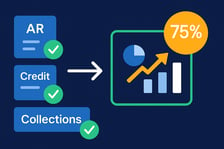Why streamline your payment processes?
Why should businesses streamline their payment processes? Because it not only saves time but also reduces the errors that stem from inefficient systems. An organized payment process allows other areas of the business to run more smoothly, and it builds trust with customers, as they’ll appreciate the clarity and ease of paying. A business with a streamlined payment system appears more professional, which can improve customer satisfaction and loyalty.
Automating the accounting process is crucial in this regard, as it eliminates much of the human error that comes with manual processes. Software can catch mistakes in real time, preventing costly delays and inefficiencies. This leads to faster payments and smoother operations.
Furthermore, when customers can easily access clear payment methods, they are more likely to pay on time. Late or missing payments are a common reason small businesses struggle or even fail, and simplifying the payment process can significantly reduce this risk. A seamless payment experience not only reduces late payments but also strengthens customer relationships by showing you value their time and business.
Another benefit of streamlining payments is staying up-to-date with accounts receivable. You can quickly track outstanding payments, identify customers who may be late, and follow up more efficiently. This proactive approach to managing your receivables helps ensure your cash flow remains steady and organized.
Finally, keeping all accounts and records neatly organized within a streamlined system prevents chaos, allowing for easy access to invoices and transaction details. This level of organization is crucial for effective financial management and can make both manual and automated processes run far more efficiently. By maintaining an orderly payment system, businesses can enhance overall operations and minimize the risks that come with disorganization.
Steps to streamline payments
There are a few steps that come with streamlining payments. The first is to use a payment processing program or automated solution that coincides with your business. For example, if you own an eCommerce store, look for a provider that specializes in eCommerce payment processing.
Most payment solutions are designed to integrate with your current bookkeeping system (QuickBooks is one of the most common). Look for an option that’s simple and concise. The payment programs with the fewest steps are likely the best to use because they're easy to keep track of and use regularly.
Next, always email a receipt to the customer once the payment has gone through, so they have it in their records. This saves time later when they need to reconcile their accounts—and reduces the number of requests for proof of payment documentation.
Finally, keeping up with new payment technology will help to keep your business up to date and competitive. All these steps will really improve a business’ ability to streamline payments while increasing efficiency.
The ultimate efficiency is to use a system where everything to do with invoicing/payment processing is integrated. When creating an invoice, sending an invoice, receiving payment, and processing the payment are all done in the same system, errors are drastically reduced, there’s less human labor involved, and the risk of missing a payment or sending a duplicate invoice are reduced (or, in many cases, eliminated completely).
One note about the use of OCR (optical character recognition) software as part of a streamlining process: while this allows for scanning and digitizing of invoices, it’s still a system that requires manual initiation. As well, the software’s accuracy decreases as more fields are added to invoices. A better solution is to use software that can fully manage the invoicing from start to finish.
Small businesses and streamlining payment processes
With a simplified and polished system, mistakes are few and far between, meaning the business and its customers will have more timely cash flow. The bottom line is that shifting a bit of time and resources to go toward payment streamlining now will save time and money at the end of every month.
Without streamlining, there’s a risk of having the business’ working capital tied up in a stack of paper at the end of the desk. Sending, receiving, and processing invoices manually leads to bottlenecks in payments.
One B2B payment processing system that’s ideal for small and medium businesses is through a fintech company called Resolve. A key demand by most business customers is net terms—the ability to pay for products/services 30, 60, or 90 days after receiving an invoice.
Doing this creates a few challenges for the seller: how much credit to extend to the customer, which net terms to offer, and how to survive as a business while waiting months for payment.
With Resolve, businesses can conduct discrete credit checks on any US customer and receive recommendations on how much credit and which net terms to offer to each customer. (This varies based on their creditworthiness, payment history, and other information.) Then, Resolve pays the business up to 90% of each approved customer’s invoice within one day of issuing it. Payment is made directly into the business’ bank account.
The customer gets the net terms they want, and the business gets paid quickly, which helps to solve cash flow and working capital problems. In addition, Resolve provides each business with a branded payment platform where each of their customers can log into their account, see all their invoicing and credit information, and easily make payments using their business credit card, bank transfer or ach, or even mail a check. The processing is automatic and very user-friendly for both parties—the perfect solution for accounts receivable.
Payment processing platforms and merchant services
There are also payment processing platforms available to businesses that help streamline their payment and credit card processing.
To make for a positive experience for both your office and your customers, consider using a payment processing system that fits the needs of your business. One is the Clover payment processing solution, which is made to be used at a storefront and provides a merchant account. It can report inventory and allows the customer to control the receipt options. Clover takes pos as debit card payments, mastercard and visa, online payment services such as Apple Pay, and it can even go as far as scanning and submitting cheque payments.
Another is Streampay, which is a cloud-based payment processing system that works with eCommerce stores. It takes payments via a virtual terminal, a hosted payment portal, or through API. Streampay can accommodate a business of any size, and it securely stores customer data while meeting the PCI regulations. At the same time, it automatically processes any reoccurring payments on a payment schedule. It can even track and analyze sales and cash flow statistics.
Both Clover and Streampay are easily implemented into the pre-existing software that the business uses.
Invoice processing
Streamlining isn’t only for direct transactions — it’s for invoices too. Streamlining the invoice processing system improves the efficacy and timing of sending and receiving invoices, and when the business gets paid.
Within the lifecycle of any invoice, the best option requires less time and offers more accuracy. An automated system helps to keep customers happy and money flowing, but also protects the business from costly mistakes. As your business grows, invoice processing needs will change. Having a system that’s efficient and scalable will help transition to selling to more customers with the same ease of processing.
The Covid-19 pandemic has highlighted what many businesses already knew—any solutions that make business processes easier and more efficient, decrease data entry requirements, allow for electronic payments, and improve workflow are essential parts of keeping the doors open and growing your business. Streamlining payments is a big part of this.




%20Alternatives%20Best%20B2B%20Financing%20Solutions%20for%202025.jpg?width=385&height=202&name=P2Binvestor%20(P2Bi)%20Alternatives%20Best%20B2B%20Financing%20Solutions%20for%202025.jpg)

